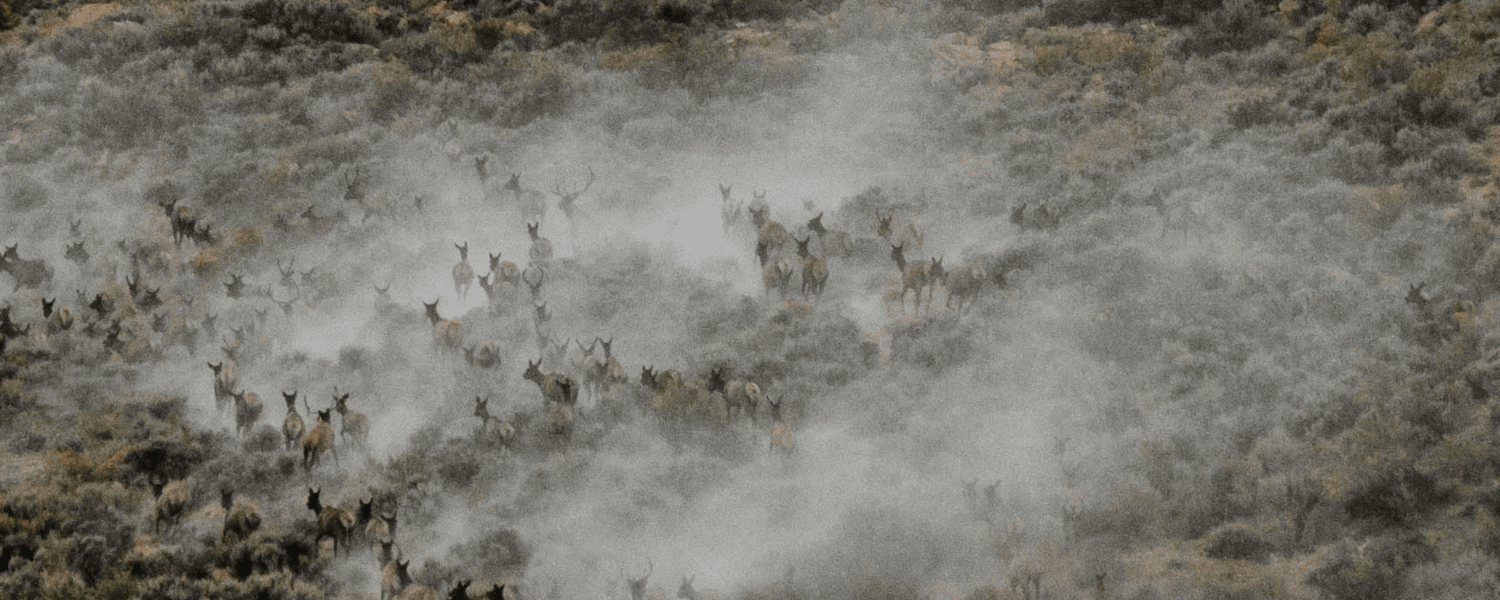Two elk-related bills are poised to emerge from the Agriculture Committee, where lawmakers took on an unassigned topic because of dissatisfaction with another committee’s response.
By Mike Koshmrl, WyoFile.com
Ordinary hunting will never reduce elk numbers to their target levels, Rep. John Winter (R-Thermopolis) opined to fellow members of the Joint Agriculture, State and Public Lands and Water Resources Committee.
As an alternative, he suggested commissioning a helicopter crew to gun down overpopulated herds that are eating grass, busting fences and generally giving Wyoming ranchers headaches.
“If we’re going to get this job done, we’re going to have to change our whole approach,” Winter said at the committee’s June 6 meeting in Torrington. “I really believe that if you get the right pilot and the right organization, we could take care of this problem in a relatively short time.”
Rep. Bob Davis (R-Baggs), a fellow committee member, lofted out another aerial idea: Why not suspend the Wyoming Game and Fish Department’s drone prohibition to give hunting guides the upper hand in locating wapiti.
Rep. John Eklund (R-Cheyenne), a committee co-chair, questioned whether elk killed from within inflated herds need to be processed: “Can they just be gunned,” he asked, “and let the coyotes take care of the carcasses?”
The Agriculture Committee’s other chair, Sen. Cheri Steinmetz (R-Lingle), floated another option for handling all the potential meat in places like the Laramie Mountains and Iron Mountain, where elk populations are double to triple the state’s objectives.
“Is there any way you could sell the meat to help recoup some of the costs for the landowners?” she said. “Has any of that been contemplated?”
Craig Smith, the deputy chief of wildlife for the Wyoming Game and Fish Department, offered the same answer to each inquisitive legislator’s brainstormed solution to overpopulated elk herds in eastern and central Wyoming. Responding to one suggestion after the next, he told lawmakers their ideas were illegal.
Smith explained to Eklund, for example, that Wyoming law prohibits wanton waste of game meat.
“It’s just not something that the public is going to stomach,” he said of leaving dead elk to decay. “I personally wouldn’t stomach it.”
The barrage of elk management ideas were not only unconventional vis-a-vis game laws and ethical hunting standards, they also came from a committee that doesn’t often deal with wildlife policy.
In fact, the Wyoming Legislature’s Management Council did not task the Agriculture Committee to address overpopulated elk or help landowners cope with them. But the 15 lawmakers on the committee heard rancher testimony about elk and are drafting bills to address the issue because some of its leadership felt that the normal avenue for elk-related bills — the Joint Travel, Recreation, Wildlife and Cultural Resources Committee — was “unable to move policy along to get these numbers down,” Eklund said.
“The problem is you’ve got committees that work with certain agencies and they are trying to not get crosswise with them because they work with them constantly,” he told WyoFile. “The ag committee is a little less concerned with that.”
‘Unable to move policy along’
Not every Agriculture Committee member agreed with the decision to wade into the topic.
“If I was the chairman, we would not have taken this on,” Sen. Larry Hicks (R-Baggs) said. “It wasn’t a topic that was presented to [Management Committee], it wasn’t presented by anybody and it’s kind of TRW’s purview. I’m not the chairman, but I think we should exercise better discretion.”
At the Torrington meeting, longtime livestock industry lobbyist Jim Magagna and several cattle ranchers spoke about their frustrations with elk before Game and Fish’s Smith presented data, the agency’s perspective and what’s been attempted so far.
Charlie Farthing, who ranches in the Iron Mountain Herd’s range, told lawmakers that, although they’re a native species, elk were absent on his family’s rangeland until the mid-1970s, when the state transplanted animals from the Yellowstone region.
“When these elk were put in, nobody said anything to us,” Farthing testified.
The elk expanded beyond the reintroduction area, he said, “kind of like when they put the wolves in Yellowstone.”
Wheatland-area rancher Juan Reyes charged that Game and Fish was “depriving landowners the opportunity of profitability.”
“That’s a taking,” the Cuban-born Reyes said. “And I came to this country because of socialism.”
Another Wheatland-area rancher, Don Willis, was less aggressive in his criticism of the state agency. “I’m not an expert, I don’t know all the details of Game and Fish,” he said. “But we live with it every day. I mean, we have elk-damaged fences 50 yards from the house. We are in the thick of it.”
When Game and Fish’s Smith fielded lawmakers’ questions, he faced scorn for his agency’s failure to hunt down elk numbers in a region where private property dominates and where savvy elk have learned to take refuge on parcels where hunting isn’t allowed.
“People that I consider experts — you — are just waiting at the train station waiting to get run over by this situation,” Sen. John Kolb (R-Rock Springs) told Smith. “Do you realize that something has to be done? What are we going to do?”
Game and Fish probably got unfairly beat up in the meeting, Eklund told WyoFile. The lawmakers, he said, were dealing with a new topic they knew little about before the ranchers’ testimony.
“The ag committee is a pretty new committee, and we have a lot of freshmen,” Eklund said. “A lot of what we’re doing constantly is education. Through that education you might throw out some ideas that have been tried before or are illegal.”
Made it through
A couple of potential elk-policy changes are poised to emerge from the Agriculture Committee.
One Hicks-led bill draft proposes some reform to Wyoming’s landowner license system. That’s a type of near-guaranteed license, sometimes subject to abuse, that the governor-appointed Wyoming Wildlife Taskforce couldn’t come to agreement on altering in 2022.
Hicks’ proposal would make landowner elk licenses transferable to other people in areas where elk populations are more than 120% of the state’s objective for three consecutive years. One provision he’s kicked around would necessitate that 50% of the transferred licenses end up with Wyoming residents. He’s not looking to increase the number of licenses eligible property owners can receive, currently two per species.
“We need something that people can support that’s pretty simple,” Hicks said.
Magagna, executive vice president of the Wyoming Stock Growers Association, proposed the other piece of legislation the Agriculture Committee voted to pursue. He’d like lawmakers to amend wildlife-damage laws to make landowners automatically eligible for payments in areas where elk or other big game species are more numerous than the state’s goal.
Those payments would be based on estimations of the amount of grass over-objective elk and other big game species consume, and how much land individual stockgrowers graze. To be eligible, stockgrowers would have to “be willing to negotiate” with Game and Fish about “reasonable hunter access.”
The proposed elk-eaten grass reimbursement wouldn’t be limited to private property.
“I’m including leased state lands,” Magagna told the committee.
The reason, he explained, is that grazing leases on state lands are based on the estimated amount of forage available — not the number of livestock.
“If the elk are taking that forage,” Magagna said, “you’re suffering the same loss there as you are on your private land.”
Magagna told WyoFile he’s not intending to seek reimbursement for grass that elk and other wildlife are eating on national forest, Bureau of Land Management property and other federal land.
“On federal lands, no matter what my permit says,” he said, “I only pay for the number of [domestic] animals that actually graze each year.”
Status quo solution?
Game and Fish, meanwhile, is ramping up its own efforts to try to drive down elk numbers in the most overpopulated areas.
Last summer the state agency acted on another proposal emanating from the Wyoming Stock Growers Association, rebranding and updating its seldom-used depredation hunts as “auxiliary management” hunts.
Those hunts are devised completely outside of the agency’s normal season-setting process and geared toward addressing private-land-dwelling herds. The state hadn’t held a depredation hunt since 2004, but last winter wildlife managers authorized a “handful” of them. One example, Game and Fish Chief Warden Rick King said, was on four ranches south of Laramie, where 32 hunters killed 39 elk during the month of February.
“We look forward to implementing that more as we move forward,” he testified.
King spoke to the Travel, Recreation, Wildlife and Cultural Resources Committee, which met in Evanston and discussed overpopulated elk the week after their counterparts on the Agriculture Committee did so.
Winter, who sits on both committees, reiterated his view that the status quo will never achieve population goals in the most elk-crowded areas.
“We have to do something to help these ranchers,” he said. “They can’t stay in business when they’re trying to deal with all these elk.”
King, however, spoke optimistically about achieving the state’s elk objectives without having to radically realign management. Although the Iron Mountain Herd is roughly triple its 1,800-animal population goal, hunters could trim numbers toward the desired size by killing 800 or 900 cows and calves a year — about a doubling of the current take.
“It’s not unreasonable,” King said. “It’s going to take a lot of collaboration among landowners and it’ll take the full use of tools that we have.”
Another one of those tools is paying hunters to kill elk.
That’s a legal approach via Game and Fish regulations. Ordinarily those permits are distributed to agency personnel themselves, but last winter Game and Fish debuted contracting elk hunters to thin the Iron Mountain Herd. At a cost of roughly $20,600, two hired hands managed to kill 129 elk — penciling out to $160 per animal. The meat from all but one of them, which tested positive for chronic wasting disease, was salvaged and distributed via the Food from the Field program.
King’s confident he can scale that hired hunter system up and make progress.
“In terms of compensation for damage and in terms of addressing populations,” he said, “I think the commission, department and private landowners can make significant headway.”





